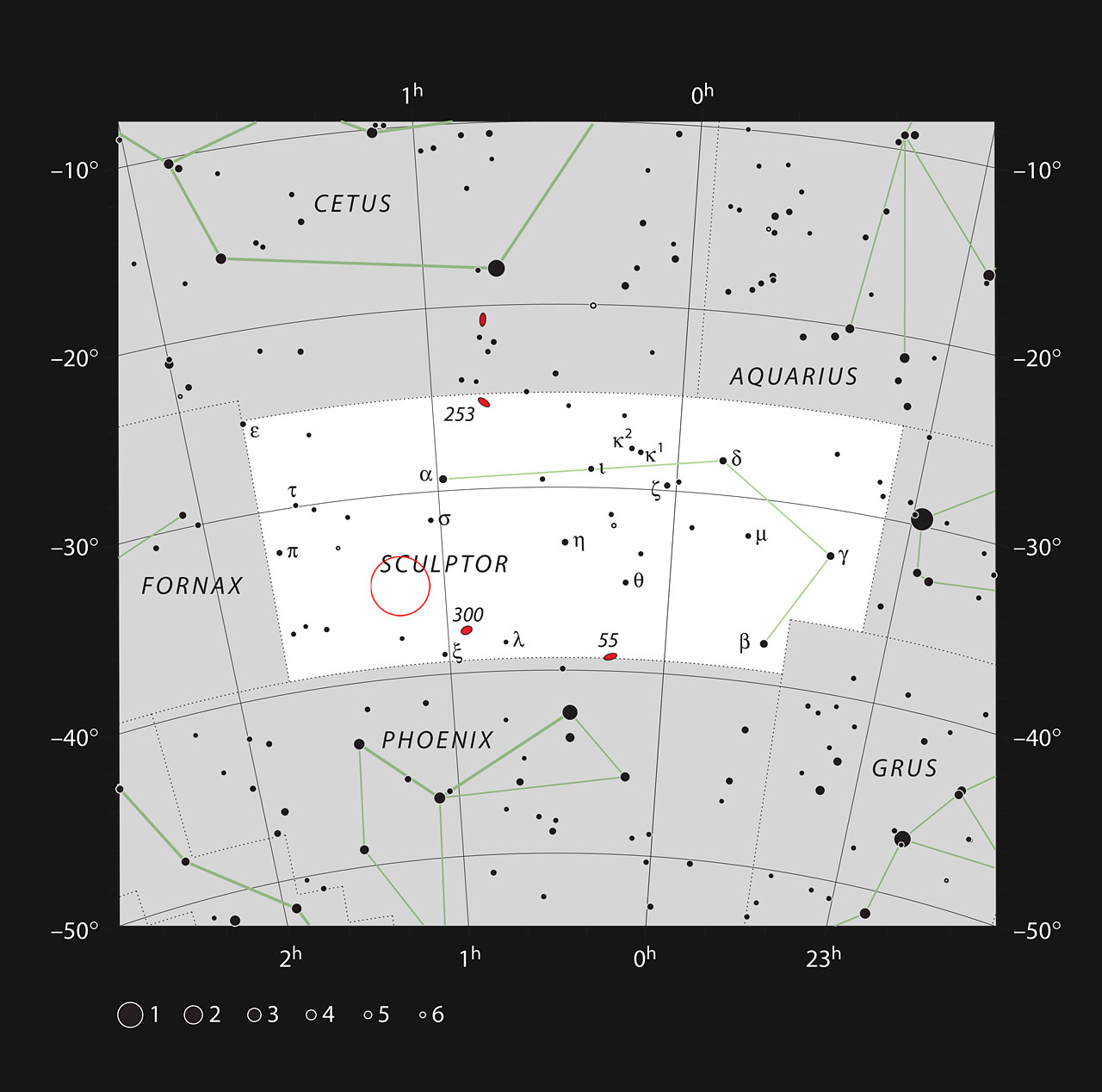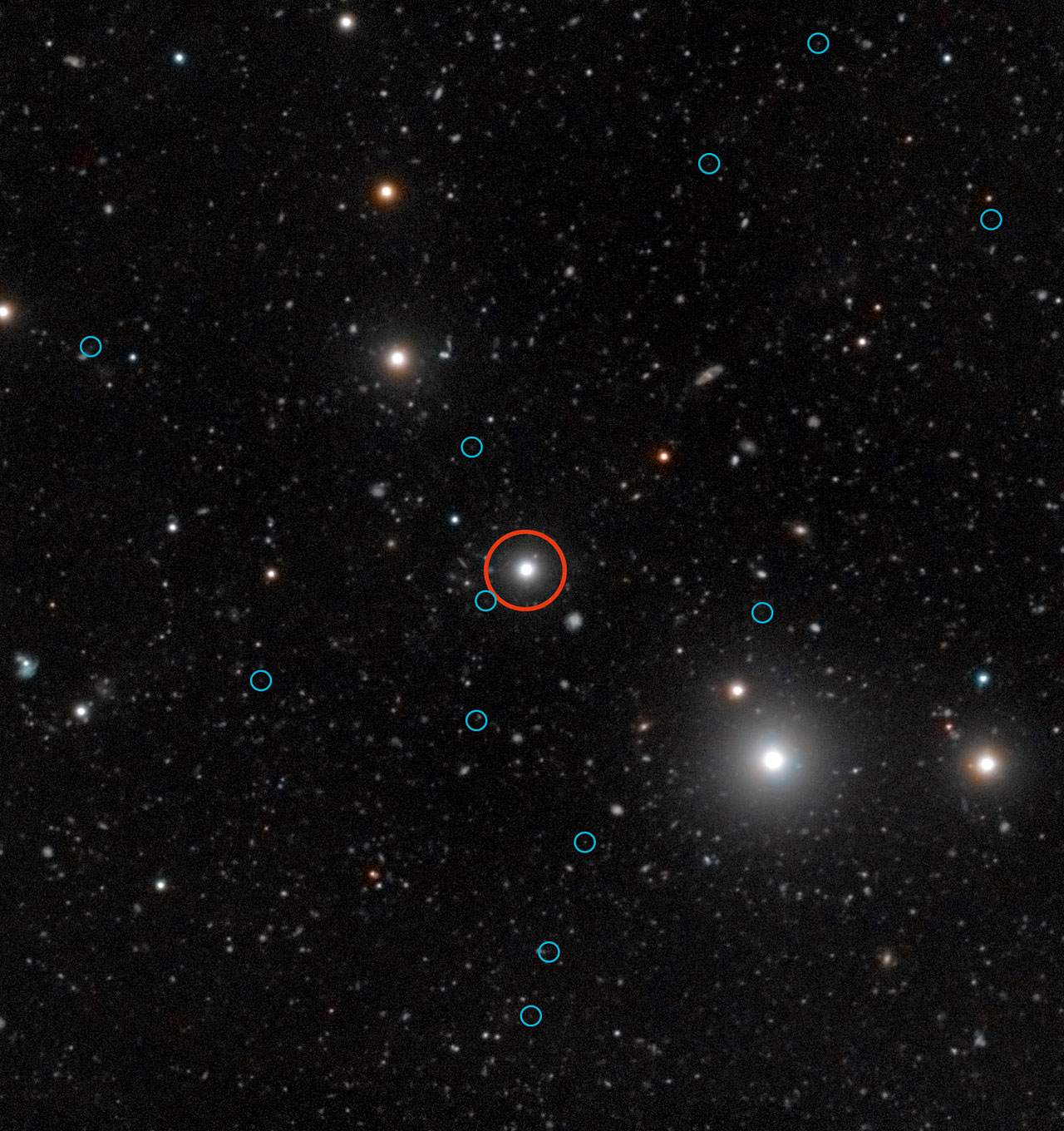Dark galaxies are essentially gas-rich galaxies in the early Universe that are very inefficient at forming stars and astronomers think they have detected these elusive objects by observing them glowing as they are illuminated by a quasar. They are predicted by theories of galaxy formation and are thought to be the building blocks of today’s bright, star-filled galaxies. They may have fed large galaxies with much of the gas that later formed into the stars that exist today.
Because they are essentially devoid of stars, dark galaxies don’t emit much light, making them very hard to detect. Astronomers have been trying to develop new techniques that could confirm the existence of these galaxies and small absorption dips in the spectra of background sources of light have hinted at their existence. However, this new study marks the first time that such objects have been seen directly.

Quasar HE0109-3518 in the constellation Sculptor, including most of the stars visible to the unaided eye under good conditions. The location of the quasar itself is marked with a red circle. Credit: ESO, IAU and Sky&Telescope
“Our approach to the problem of detecting a dark galaxy was simply to shine a bright light on it.” explains Simon Lilly, ETH Zurich, co-author of a new paper on the topic. “We searched for the fluorescent glow of the gas in dark galaxies when they are illuminated by the ultraviolet light from a nearby and very bright quasar. The light from the quasar makes the dark galaxies light up in a process similar to how white clothes are illuminated by ultraviolet lamps in a night club.”
Fluorescence is the emission of light by a substance illuminated by a light source. In most cases, the emitted light has longer wavelength than the source light. For instance, fluorescent lamps transform ultraviolet radiation — invisible to us — into optical light. Fluorescence appears naturally in some compounds, such as rocks or minerals but can be also added intentionally as in detergents that contain fluorescent chemicals to make white clothes appear brighter under normal light.
The researchers used the large collecting area and sensitivity of the Very Large Telescope (VLT) for a series of very long exposures to detect the extremely faint fluorescent glow of the dark galaxies. They used the FORS2 instrument to map a region of the sky around the bright quasar HE 0109-3518, looking for the ultraviolet light that is emitted by hydrogen gas when it is subjected to intense radiation. Because of the expansion of the Universe, this light is actually observed as a shade of violet by the time it reaches the VLT.
This emission from hydrogen is known as Lyman-alpha radiation, and is produced when electrons in hydrogen atoms drop from the second-lowest to the lowest energy level. It is a type of ultraviolet light. Because the Universe is expanding, the wavelength of light from objects gets stretched as it passes through space. The further light has to travel, the more its wavelength is stretched. As red is the longest wavelength visible to our eyes, this process is literally a shift in wavelength towards the red end of the spectrum — hence the name ‘redshift’. The quasar HE 0109-3518 is located at a redshift of z = 2.4, and the ultraviolet light from the dark galaxies is shifted into the visible spectrum. A narrow-band filter was specially designed to isolate the specific wavelength of light that the fluorescent emission is redshifted to. The filter was centered at around 414.5 nanometers in order to capture Lyman-alpha emission redshifted by z=2.4 (this corresponds to a shade of violet) and has a bandpass of only 4 nanometers.

The sky around the quasar HE0109-3518, labeled with a red circle near the center of the image. The energetic radiation of the quasar makes dark galaxies glow, helping astronomers to understand the obscure early stages of galaxy formation. The faint images of the glow from 12 dark galaxies are labeled with blue circles. Dark galaxies are essentially devoid of stars, therefore they don’t emit any light that telescopes can catch. This makes them virtually impossible to observe unless they are illuminated by an external light source like a background quasar. The Very Large Telescope was tuned to detect the fluorescent emissions produced by the quasar illuminating the dark galaxies, with color data from the Digitized Sky Survey 2. Credit: ESO, Digitized Sky Survey 2 and S. Cantalupo (UCSC)
The team detected almost 100 gaseous objects which lie within a few million light-years of the quasar. After a careful analysis designed to exclude objects where the emission might be powered by internal star-formation in the galaxies, rather than the light from the quasar, they finally narrowed down their search to 12 objects. These are the most convincing identifications of dark galaxies in the early Universe to date.
The astronomers were also able to determine some of the properties of the dark galaxies. They estimate that the mass of the gas in them is about 1 billion times that of the Sun, typical for gas-rich, low-mass galaxies in the early Universe. They were also able to estimate that the star formation efficiency is suppressed by a factor of more than 100 relative to typical star-forming galaxies found at similar stage in cosmic history.
The star formation efficiency is the mass of newly formed stars over the mass of gas available to form stars. They found these objects would need more than 100 billion years to convert their gas into stars. This result is in accordance with recent theoretical studies that have suggested that gas-rich low-mass haloes at high redshift may have very low star formation efficiency as a consequence of lower metal content.
More information
Article: "Detection of dark galaxies and circum-galactic filaments fluorescently illuminated by a quasar at z=2.4", by Cantalupo et al. will appear in Monthly Notices of the Royal Astronomical Society.





Comments